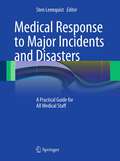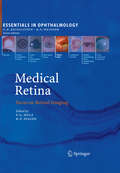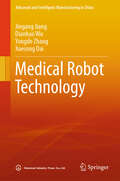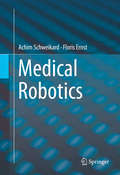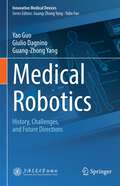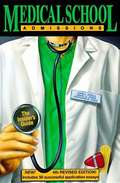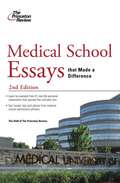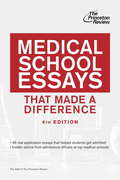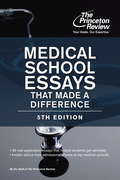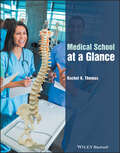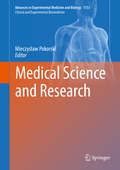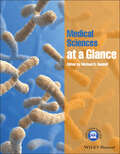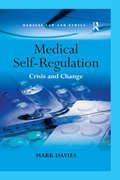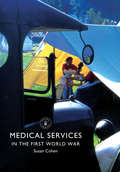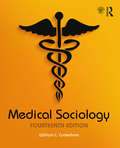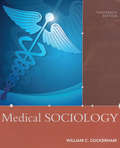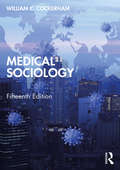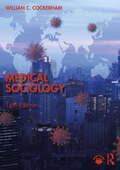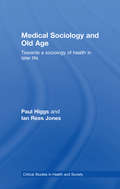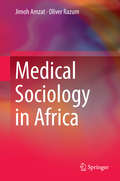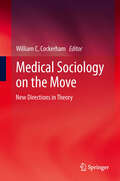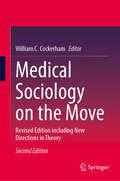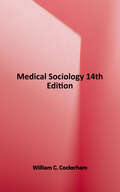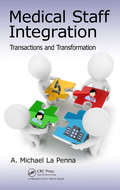- Table View
- List View
Medical Response to Major Incidents and Disasters
by Sten LennquistThis book, written by members of the core faculty responsible for European courses on Medical Response to Major Incidents (MRMI), is a practical guide for all medical staff on how to respond to a wide range of disaster scenarios. The entire spectrum of knowledge is covered, from command and coordination through to the management of individual casualties. Central importance is attached to the key component of decision making by explaining what needs to be done for patients in particular situations and the required order and timing of treatment measures. Simplified methods receive due attention, as it is often necessary for medical staff to administer primary treatment outside of their own specialty. This book will prove an invaluable aid to all who may be involved in the response to major accidents and disasters, including medical and nursing students, ambulance crew, and military personnel as well as medical specialists.
Medical Retina
by Frank G Holz Richard F. SpaideRecent advances in ophthalmic imaging technology have revolutionized fundus examination and contributed significantly in elucidating the pathophysiology of retinal diseases and improving their diagnosis and treatment. It is therefore fitting that this detailed full-color textbook in the Medical Retina series is devoted to ocular imaging. The volume reviews in detail the role of both established and novel forms of imaging, and is designed to be of benefit to clinicians and researchers alike. All of the chapters have been written by internationally recognized experts at the forefront of their fields. The result is a comprehensive, state-of-the-art overview of retinal imaging that should prove informative and useful for everyone interested in the retina. Topics include: *Spectral domain optical coherence tomography (SD-OCT) of macular diseases *Comparison of OCT equipment *Simultaneous SD-OCT and confocal SLO imaging *Ultra-widefield imaging °Autofluorescence imaging *Near-infrared imaging *Macular pigment imaging *Metabolic mapping *Imaging of the choroid *Imaging the vitreous and the vitreoretinal interface with SD-OCT *New developments in OCT technology *Molecular imaging
Medical Risk Prediction Models: With Ties to Machine Learning (Chapman & Hall/CRC Biostatistics Series)
by Thomas A. Gerds Michael W. KattanMedical Risk Prediction Models: With Ties to Machine Learning is a hands-on book for clinicians, epidemiologists, and professional statisticians who need to make or evaluate a statistical prediction model based on data. The subject of the book is the patient’s individualized probability of a medical event within a given time horizon. Gerds and Kattan describe the mathematical details of making and evaluating a statistical prediction model in a highly pedagogical manner while avoiding mathematical notation. Read this book when you are in doubt about whether a Cox regression model predicts better than a random survival forest. Features: All you need to know to correctly make an online risk calculator from scratch Discrimination, calibration, and predictive performance with censored data and competing risks R-code and illustrative examples Interpretation of prediction performance via benchmarks Comparison and combination of rival modeling strategies via cross-validation Thomas A. Gerds is a professor at the Biostatistics Unit at the University of Copenhagen and is affiliated with the Danish Heart Foundation. He is the author of several R-packages on CRAN and has taught statistics courses to non-statisticians for many years. Michael W. Kattan is a highly cited author and Chair of the Department of Quantitative Health Sciences at Cleveland Clinic. He is a Fellow of the American Statistical Association and has received two awards from the Society for Medical Decision Making: the Eugene L. Saenger Award for Distinguished Service, and the John M. Eisenberg Award for Practical Application of Medical Decision-Making Research.
Medical Robot Technology (Advanced and Intelligent Manufacturing in China)
by Jingang Jiang Dianhao Wu Yongde Zhang Xuesong DaiThis book mainly describes the basic principles, basic knowledge and application of medical robots. The book includes the characteristics and classification of the medical robot, the key technology of medical robot and the engineering research of clinical application of medical robot. While expounding the basic principles and knowledge, this book pays attention to its clinical application research. From the research background, research significance, key technologies and typical examples, hospital service robot, neurosurgery robot, vascular intervention robots, laparoscopic robot, capsule robot, prostate minimally invasive interventional robot and breast minimally invasive interventional robot, orthopedic robot, rehabilitation robot, complete denture tooth-arrangement robot, orthodontic archwire bending robot and other medical robots are analyzed and described. On this basis, the development of medical robots is analyzed from the perspectives of policies and regulations, market, industry chain structure and technology. This book is suitable for researchers, senior undergraduate students and postgraduate students and industry practicing engineers in medical robots and biomedical engineering to consolidate the basic principles and knowledge and learn about the industry frontiers. And it also is suitable for clinicians to understand relevant engineering practices.
Medical Robotics
by Achim Schweikard Floris ErnstThis book provides a thorough background to the emerging field of medical robotics. It covers the mathematics needed to understand the use of robotic devices in medicine, including but not limited to robot kinematics, hand-eye and robot-world calibration, reconstruction, registration, motion planning, motion prediction, motion correlation, motion replication and motion learning. Additionally, basic methods behind state-of-the art robots like the DaVinci system, the CyberKnife, motorized C-arms and operating microscopes as well as stereotactic frames are presented. The book is a text book for undergraduates in computer science and engineering. The main idea of the book is to motivate the methods in robotics in medical applications rather than industrial applications. The book then follows the standard path for a robotics textbook. It is thus suitable for a first course in robotics for undergraduates. It is the first textbook on medical robotics.
Medical Robotics: History, Challenges, and Future Directions (Innovative Medical Devices)
by Guang-Zhong Yang Yao Guo Giulio DagninoThis book outlines the global trends and new research directions of medical robotics, while also highlighting associated technical, commercial, regulatory, and economic challenges. In particular, it focuses on three areas of medical robotics: (i) robotic surgery, (ii) rehabilitation and personal assistance, and (iii) hospital automation. With improved safety, efficacy and reduced costs, robotic platforms will soon approach a tipping point, moving beyond early adopters to become part of the mainstream clinical practice, defining the future of smart hospitals and home-based patient care. This book provides an up-to-date, concise, focused, and effective overview of medical robotics, making the content suitable for readers with different technical backgrounds, including bioengineering, robotics, computer science, as well as clinical professionals. The clarity of the exposure of complex topics in simple way makes the book a unique resource for both experienced professionals and novices who approach medical robotics. As a reference for medical robot research, readers can select some chapters according to their own interests.
Medical School Admissions: The Insider's Guide (4th Revised Edition)
by John A. Zebala Daniel B. Jones Stephanie B. JonesThis book offers practical advice on college studies, the MCAT, extracurricular activities, and interview techniques. It also has 50 successful application essays that give examples and inspiration to students.
Medical School Essays That Made a Difference
by The Princeton ReviewMany pre-med students have great MCAT scores and excellent grades--the best way to stand out in a crowd of medical school applicants is to write an exceptional essay!
Medical School Essays That Made a Difference, 4th Edition
by Princeton ReviewStand out from the med school application crowd with an essay that makes a statement. Gaining admission to a top medical school requires more than "just" a stellar MCAT score and an excellent GPA. You'll also need to nail your personal statement. In this book, you'll find the help you need to do just that: * 45 real essays written by 39 unique future doctors, along with each applicant's test scores, GPA, and admissions profile * An overview of med school admissions and financial aid, including a breakdown of the "anatomy" of the application * Interviews with admissions officers who have read thousands of application essaysThis fourth edition of Medical School Essays that Made a Difference includes application essays from students who enrolled at the following schools:Baylor College of MedicineCase Western Reserve University, Cleveland Clinic Lerner College of MedicineCornell University, Weill Medical CollegeEdward Via Virginia College of Osteopathic MedicineGeorgetown University, School of MedicineJohns Hopkins University, School of MedicineMedical College of GeorgiaMeharry Medical College, School of MedicineMichigan State University, College of Osteopathic MedicineNew York University, NYU School of MedicineRush University, Rush Medical CollegeTemple University, School of MedicineThomas Jefferson University, Jefferson Medical CollegeTulane University, School of MedicineUniversity of California--San Francisco, School of MedicineUniversity of Minnesota--Twin Cities, Medical SchoolUniversity of North Dakota, School of Medicine and Health SciencesUniversity of South Alabama, College of MedicineUniversity of South Florida, College of MedicineUniversity of Southern California, Keck School of MedicineUniversity of Virginia, School of MedicineUniversity of Wisconsin--Madison, School of MedicineVirginia College of Osteopathic MedicineWashington University in St. Louis, School of MedicineYale University, School of MedicineYeshiva University, Albert Einstein College of Medicine
Medical School Essays That Made a Difference, 5th Edition
by Princeton ReviewThe inside word on medical school admissions.Gaining admission to a top medical school requires more than "just" a stellar MCAT score and an excellent GPA. You'll also need to nail your personal statement. In this book, you'll find the help you need to do just that: * 45 real essays from future doctors, along with each applicant's MCAT scores, GPA, and admissions profile * An overview of med school admissions and financial aid, including a breakdown of the "anatomy" of the application * Interviews with admissions officers who have read thousands of application essaysThis fifth edition of Medical School Essays That Made a Difference includes application essays from students who enrolled at the following schools:Cornell University, Joan and Sanford I. Weill Medical CollegeGeorgetown University, School of MedicineJohns Hopkins University, School of MedicineNew York University, NYU School of MedicineTemple University, School of MedicineTulane University, School of MedicineUniversity of Virginia, School of MedicineUniversity of Wisconsin--Madison, School of Medicine and Public HealthYale University, School of MedicineFrom the Trade Paperback edition.
Medical School at a Glance
by Rachel K. ThomasStarting Medical School can be incredibly daunting, and the transition to being a medical student can be enormously challenging. Medical School at a Glance is an accessible guide to help give you confidence and to gain a running start to your medical school training. Covering core areas such as medical training, developing effective learning strategies, understanding common principles, learning how to behave in the clinical setting and how to interact with patients and peers, this book will help to demystify the process and prepare you as you embark on your medical career. Providing an insider's view of useful information to build a solid basic foundation for your learning, Medical School at a Glance is essential for those considering studying medicine or are in their first years of study.
Medical Science and Research (Advances in Experimental Medicine and Biology #1153)
by Mieczyslaw PokorskiThis book shares the latest research and practice-oriented findings in medical sciences with a wide audience. It addresses a range of contemporary issues, often unresolved or contentious, across various medical fields, including advances in the management of hemorrhagic brain stroke. It also discusses metastatic renal cell carcinoma – a global scourge with an extremely poor long-term survival prognosis, the course and sequelae of renal cell carcinoma, as well as advances in targeted molecular therapy with sunitinib, a receptor tyrosine kinase inhibitor. Further, it examines the molecular targeting of proliferative signaling of the epidermal growth factor receptor in the first-line treatment of patients with metastatic non-small-cell lung cancer. Other articles cover clearance of toxins in hemodialyzed patients; the search for diagnostic and therapeutic markers in the connective tissue disease scleroderma; obesity linked to inappropriate dietary habit; clinical problems related to the diagnosis of sensitization to fungi and its role in asthma; and reasons for the perilous trend of avoiding basic vaccinations in children. Lastly, the book explores the rapid developments in e-health technologies that increase access to health services, particularly for the elderly. The book is intended for clinical specialists, researchers, and all allied health professionals from various fields.
Medical Sciences at a Glance
by Michael D. RandallThe definitive companion for medical science study and revision Medical Sciences at a Glance consolidates the scientific knowledge a student needs to know to provide a solid framework of key facts to build on. Concise, easy to follow, written specifically for medical students, and using the unique at a Glance style to convey key concepts, Medical Sciences at a Glance also demonstrates vital links between different topics and across systems. It is the perfect resource for bridging the gap between A-Level and university, studying a new topic, revising for exams, or refreshing knowledge while on placement. Key features: Fully cross-referenced to Medicine at a Glance: together they cover the core concepts of an entire medical degree Highlights key points and their clinical relevance for quick revision and retention of what's most important Brings together all the scientific content on a medical course in one easy-to-read, highly-illustrated title Accompanied by a companion website at ataglanceseries. com/medicalsciences featuring interactive multiple-choice questions and key points for revision Medical Sciences at a Glance provides the vital scientific grounding needed to succeed at medical school.
Medical Self-Regulation: Crisis and Change (Medical Law and Ethics)
by Mark DaviesSelf-regulation constitutes an important aspect of the regulatory and oversight process governing professionals. This book focuses directly on medical self-regulation in the context of both the wider regulatory framework and that of other regulatory models. Through a critical consideration of recent events, including high-profile and controversial cases, it is demonstrated that the self-regulatory process has failed and that only fundamental restructuring and a radical change in attitudes on the part of members of the profession can repair the damage. Attention is also given to the recent changes, current proposals for change and to alternative regulatory models. Medical Self-Regulation will be of international interest, appealing to policy makers, as well as students and practitioners in the fields of medicine, medical law and sociology and professional regulation.
Medical Services in the First World War
by Susan CohenTrench warfare, advances in weaponry and disastrous military planning led to horrific types of injuries and an unprecedented scale of mass casualties during World War I. This is the amazing and little known story of the medical service personnel and the organized system of critical care which provided a lifeline of hope and humanity in the midst of devastation, disfigurement and death during the Great War. For the first time ever, an all-out effort was made to preserve life, starting with the heroic medical service personnel who were the battlefield first line of defense, risking life and limb to save and extract wounded soldiers and evacuate them to makeshift frontline hospitals or to long-term care facilities such as Highclere Castle, as depicted in Downton Abbey, when hospitals were filled beyond capacity. The book details their heroism and the vital role played by nurses in attending to the medical and psychological needs and boosting the morale of millions of wounded soldiers.
Medical Sociology
by William C. CockerhamThe most thorough major academic textbook available, this classic text presents the most important research studies in the field. The author also integrates engaging first-person accounts from patients, physicians, and other health care providers throughout the text. A much greater number of first person accounts and updated examples are added to the new fourteenth edition. Other updates include: • Coverage of Zika, Ebola, MERS, and updates on other pandemics • Expanded discussion of obesity as a disease • Coverage of the widening gap in life expectancy between the rich and the poor • New information on the decline of life expectancy among American white women, especially those who live in rural counties • New material on biomarkers, gene–environment interaction, and stress • Analysis of the role of the hidden curriculum in medical schools • Exiting the Affordable Care Act
Medical Sociology
by William C. CockerhamFor upper-division undergraduate/beginning graduate-level courses in Medical Sociology, and for Behavioral Science courses in schools of Public Health, Medicine, Pharmacy, and Nursing. A comprehensive overview of the most current issues in medical sociology. The standard text in the field, Medical Sociology presents the discipline's most recent and relevant ideas, concepts, themes, issues, debates, and research findings. To draw students into the course, author Dr. William Cockerham integrates engaging first-person accounts from patients, physicians, and other health care providers throughout the text. The Thirteenth Edition addresses the current changes stemming from health care reform in the United States, and other issues that reflect the focus of the field today.
Medical Sociology
by William C. CockerhamThe most comprehensive major academic textbook available on its topic, this classic text presents the most important research studies in the field. The author integrates engaging first-person accounts from patients, physicians, and other health care providers throughout the text. Since its inception, this book's principal goal has been to introduce students to the field of medical sociology and serve as a reference for faculty by presenting the most current ideas, issues, concepts, themes, theories, and research findings in the field. This new edition is heavily revised with updated data and important new additions. New to this edition: A contemporary account of medical sociology’s subfields (Chapter 1) New chapter on COVID-19 (Chapter 3) Update on the widening gap in life expectancy between the rich and the poor (Chapter 4) New chapter on gender and health, including the convergence of life expectancy between men and women and its reversal during the COVID-19 pandemic (Chapter 5) Updated chapter on aging and expanded discussion of health and race (Chapter 6) New developments in doctor-patient interaction, including telemedicine (Chapter 10) The survival of the Affordable Care Act (Chapter 16)
Medical Sociology
by William C. CockerhamThe most comprehensive major academic textbook available on its topic, this classic text presents the most important research studies in the field. The author integrates engaging first-person accounts from patients, physicians, and other health-care providers throughout the text. Since the book’s inception, its principal goal has been to introduce students to the field of medical sociology and serve as a reference for faculty by presenting the most current ideas, issues, concepts, themes, theories, and research findings in the field. This 16th edition is heavily revised, with updated data and important new additions.New to this edition: Updated chapter on the social causes, impacts, and responses to the COVID-19 pandemic (Chapter 3) Analysis of the widening ten-year gap in average life expectancy in American society between the wealthy and well-educated and the poor and less-educated (Chapter 4) Expanded discussion of the effects of racism on physical and mental health (Chapter 6) Additions to health lifestyle theory of pandemic behavior and the digitalization of society (Chapter 8) New developments in doctor–patient interaction, including the use of genomic data and artificial intelligence (AI) technology in medical care (Chapter 10) The endangered Affordable Care Act (Chapter 16) Review of key issues in different types of health-care delivery systems (Chapter 17)
Medical Sociology and Old Age: Towards a sociology of health in later life (Critical Studies in Health and Society)
by Paul Higgs Ian Rees JonesThe nature of health in later life has conventionally been studied from two perspectives. Medical sociologists have focused on the failing body, chronic illness, infirmity and mortality, while social gerontologists on the other hand have focused on the epidemiology of old age and health and social policy. By examining these perspectives, Higgs and Jones show how both standpoints have a restricted sense of contemporary ageing which has prevented an understanding of the way in which health in later life has changed. In the book, the authors point out that the current debates on longevity and disability are being transformed by the emergence of a fitter and healthier older population. This third age - where fitness and participation are valorised – leads to the increasing salience of issues such as bodily control, age-denial and anti-ageing medicine. By discussing the key issue of old age versus ageing, the authors examine the prospect of a new sociology – a sociology of health in later life. Medical Sociology and Old Age is essential reading for all students and researchers of medical sociology and gerontology and for anyone concerned with the challenge of ageing populations in the twenty-first century. This book is essential reading for all students and researchers of medical sociology and gerontology.
Medical Sociology in Africa
by Jimoh Amzat Oliver RazumThis book presents a comprehensive discussion of classical ideas, core topics, currents and detailed theoretical underpinnings in medical sociology. It is a globally renowned source and reference for those interested in social dimensions of health and illness. The presentation is enriched with explanatory and illustrative styles. The design and illustration of details will shift the minds of the readers from mere classroom discourse to societal context (the space of health issues), to consider the implications of those ideas in a way that could guide health interventions. The elemental strengths are the sociological illustrations from African context, rooted in deep cultural interpretations necessitated because Africa bears a greater brunt of health problems. More so, the classical and current epistemological and theoretical discourse presented in this book are indicative of core themes in medical sociology in particular, but cut across a multidisciplinary realm including health social sciences (e. g. , medical anthropology, health psychology, medical demography, medical geography and health economics) and health studies (medicine, public health, epidemiology, bioethics and medical humanities) in general. Therefore, apart from the book's relevance as a teaching text of medical sociology for academics, it is also meant for students at various levels and all health professionals who require a deeper understanding of social dimensions of health and illness (with illustrations from the African context) and sociological contributions to health studies in general.
Medical Sociology on the Move
by William C. CockerhamThis book provides readers with a single source reviewing and updating sociological theory in medical or health sociology. The book not only addresses the major theoretical approaches in the field today, it also identifies the future directions these theories are likely to take in explaining the social processes affecting health and disease. Many of the chapters are written by leading medical sociologists who feature the use of theory in their everyday work, including contributions from the original theorists of fundamental causes, health lifestyles, and medicalization. Theories focusing on both agency and structure are included to provide a comprehensive account of this important area in medical sociology.
Medical Sociology on the Move: Revised Edition including New Directions in Theory
by William C. CockerhamThis 2nd edition provides readers with an updated single source reviewing and updating sociological theory in medical or health sociology. The book not only addresses the major theoretical approaches in the field today, it also identifies the future directions these theories are likely to take in explaining the social processes affecting health and disease. Many of the chapters are written by leading medical sociologists who feature the use of theory in their everyday work, including contributions from the original theorists of fundamental causes, health lifestyles, and medicalization. Theories focusing on both agency and structure are included to provide a comprehensive account of this important area in medical sociology. The book includes a new chapter on life course theory.
Medical Sociology, Fourteenth Edition
by William C. CockerhamThe most thorough major academic textbook available, this classic text presents the most important research studies in the field. The author also integrates engaging first-person accounts from patients, physicians, and other healthcare providers throughout the text. A much greater number of first-person accounts and updated examples are added to the new fourteenth edition. Other updates include: - Coverage of Zika, Ebola, MERS, and updates on other pandemics - Expanded discussion of obesity as a disease - Coverage of the widening gap in life expectancy between the rich and the poor - New information on the decline of life expectancy among American white women, especially those who live in rural counties - New material on biomarkers, gene-environment interaction, and stress - Analysis of the role of the hidden curriculum in medical schools - Exiting the Affordable Care Act
Medical Staff Integration: Transactions and Transformation
by A. Michael La PennaThere is a transformation of equity occurring in the health care industry with hospitals and health systems purchasing physician practices. As traditional hospital structures meet the entrepreneurial physician manager in today‘s rapidly changing environment, numerous transitional challenges are emerging. Medical Staff Integration: Transactions and
